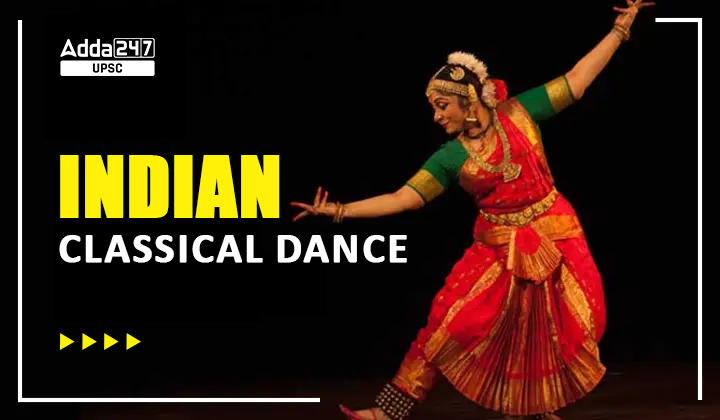Table of Contents
Indian Classical Dance: Indian Classical Dance is a rich and diverse art form that reflects the cultural heritage of India. It encompasses a range of styles, including Bharatanatyam, Kathak, Odissi, Kathakali, and more. Each style has its unique movements, expressions, and storytelling techniques. These dances are characterized by intricate footwork, graceful gestures, elaborate costumes, and mesmerizing music. Indian Classical Dance not only entertains but also serves as a medium for spiritual and emotional expression, connecting performers and audiences to centuries-old traditions.
Indian Classical Dance
Indian classical dance is a rich and vibrant art form that has deep roots in the cultural heritage of India. It encompasses a diverse range of dance styles, each with its unique characteristics and traditions. Indian classical dance is a blend of intricate footwork, graceful movements, expressive gestures, and emotive storytelling. The dance forms, such as Bharatanatyam, Kathak, Odissi, Manipuri, and Kathakali, are deeply rooted in mythology, religion, and folklore. They showcase the beauty of the human body and convey profound emotions and narratives through the language of dance. With their elaborate costumes, mesmerizing music, and skilled performers, Indian classical dances captivate audiences with their timeless charm and artistic excellence. These dances are not only a means of entertainment but also a way to preserve and celebrate India’s rich cultural heritage.
List of Indian Classical Dance
Indian Classical Dance: Candidates can check the list of indian classical dances. The list classiscal art form is mentioned below in the table.
| Indian Classical Dances | ||
| S.No | Name of Classical Dance | Place of Classical Dance |
| 1 | Bharatanatyam | Tamil Nadu |
| 2 | Kathak | Northern India |
| 3 | Kathakali | Kerala |
| 4 | Kuchipudi | Andhra Pradesh |
| 5 | Manipuri | Manipur |
| 6 | Mohiniyattam | Kerala |
| 7 | Odissi | Odisha |
| 8 | Sattriya | Assam |
- Bharatanatyam: Originating from Tamil Nadu, Bharatanatyam is one of the most popular and widely recognized classical dance forms. It is characterized by intricate footwork, expressive hand gestures, and elaborate facial expressions.
- Kathak: Kathak originated in northern India and is known for its storytelling aspect. It incorporates intricate footwork, fast spins, graceful movements, and rhythmic patterns. It often draws inspiration from mythological stories and historical events.
- Odissi: Hailing from the state of Odisha, Odissi is a graceful and lyrical classical dance form. It features fluid movements, sculpturesque poses, and intricate hand gestures. Odissi often portrays stories from Hindu mythology.
- Kathakali: Kathakali is a vibrant dance drama form from the state of Kerala. It combines dance, music, elaborate makeup, and intricate facial expressions. Kathakali performances depict mythological tales and are characterized by colorful costumes and distinctive facial makeup.
- Manipuri: Manipuri dance originates from Manipur in northeastern India. It is characterized by graceful movements, delicate footwork, and fluid hand gestures. Manipuri dance often portrays devotional themes and is accompanied by soulful music.
- Kuchipudi: Originating from the state of Andhra Pradesh, Kuchipudi is a dynamic dance form that blends storytelling, expressive movements, and rhythmic footwork. It includes graceful movements, quicksilver footwork, and a balance of masculine and feminine elements.
- Mohiniyattam: Mohiniyattam is a classical dance form from Kerala, known for its graceful and fluid movements. It is characterized by subtle facial expressions, gentle swaying, and storytelling through graceful hand gestures.
- Sattriya: Sattriya is a classical dance form from Assam that originated in the monastic tradition of the Vaishnavite sect. It is characterized by intricate footwork, graceful movements, and storytelling through hand gestures and expressions.
These are just a few examples of the diverse and vibrant classical dance styles found in India. Each style has its unique characteristics, repertoire, and cultural significance.
What are the aspects of Classical Dance?
Indian Classical Dance: Classical dance in India encompasses several aspects that contribute to its rich and distinctive nature:
- Technique and Movements: Classical dance styles have well-defined techniques and intricate movements that require years of training and practice. These include precise footwork, graceful body postures, hand gestures (mudras), facial expressions (abhinaya), and rhythmic patterns.
- Abhinaya (Expression): Abhinaya is a vital aspect of classical dance, emphasizing the art of storytelling through facial expressions, eye movements, and body language. Dancers convey various emotions, narratives, and characters, bringing life to the performance.
- Music and Rhythm: Classical dance is intricately connected to Indian classical music. Dancers synchronize their movements with the rhythm, melody, and lyrics of the accompanying music. The use of specific rhythmic patterns (tala) enhances the beauty and complexity of the dance.
- Costumes and Makeup: Classical dance is known for its elaborate costumes and vibrant makeup. Dancers adorn themselves in traditional attire, which varies according to the dance style, region, and character being portrayed. The costumes and makeup contribute to the visual appeal and help create a distinct ambiance.
- Spiritual and Cultural Significance: Classical dance is deeply rooted in Indian mythology, spirituality, and cultural traditions. It often incorporates themes from ancient epics, folklore, and religious texts, serving as a medium for spiritual and emotional expression. The dance forms are regarded as a sacred art, connecting performers and audiences to the heritage and beliefs of the Indian subcontinent
| Follow US | |
| UPSC Govt. Jobs UPSC Current Affairs UPSC Judiciary PCS Download Adda 247 App here to get the latest updates |



 TSPSC Group 1 Question Paper 2024, Downl...
TSPSC Group 1 Question Paper 2024, Downl...
 TSPSC Group 1 Answer key 2024 Out, Downl...
TSPSC Group 1 Answer key 2024 Out, Downl...
 UPSC Prelims 2024 Question Paper, Downlo...
UPSC Prelims 2024 Question Paper, Downlo...
